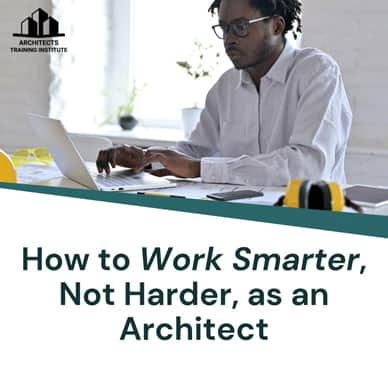How to Work Smarter, Not Harder, as an Architect
Published on October 7, 2021 by Betty White

If there is one thing that architects often lack, it's time. Whether they are students or accomplished professionals, there never seems to be enough time to do what needs to be done. So, one of the most important skills an aspiring architect needs is efficient time management. With this in mind, here are a couple tips on how to work smarter, not harder, as an architect.
Ways to work smarter, not harder, as an architect
Depending on what company you work for and your project, your job as an architect can be quite varied. Designing a small home in a U.S. city is quite different from working on skyscrapers in Dubai. Therefore, we won't go into specific on how to manage your time and your workload. Instead, we will give you some tips that have broad applications. And, with luck, you'll be able to apply some, if not all of them, to your everyday work.
Plan out your work
Almost every architectural project seems daunting at first glance. With all the different elements and tasks you need to tackle, it is easy to feel the pressure to start working as soon as possible. If you want to work efficiently, you need to control your emotions and create a plan. A comprehensive plan with a clear timeline will help you get organized, calm you down, and keep you focused. Knowing what, when and how things need to be done makes the project seem more straightforward.
Furthermore, when designing your plan, you want to make clear checkpoints. At these checkpoints, you want to see whether your plan is coming to fruition and whether you need to make changes. All in all, devising a plan is a necessary first step for any architect.
Keep track of time
One of the most important concepts to understand is that time is the most valuable resource you have. It, and only it, is completely limited, no matter how crafty or clever you are. So, if you are to work smart, you need to keep close track of it.
First, you need to keep a log of your daily activities. You will see which tasks take up your time and where you are losing. You should log every break, pause, or procrastination. Ideally, you will review your logs every week to find ways to improve your efficiency. The point is not to force yourself to be productive but to find ways to increase your productivity with minimal effort. It takes experimentation and careful time-tracking.
For creative aspects of your work, you want to make good use of your flow state. Recognizing when you have the mental capacity to undertake creative endeavors and actually doing so are necessary traits of an efficient architect. If you have multiple similar tasks at your hands, try to do them simultaneously or in close succession. That way, you can keep your mind on the same track and ensure maximum productivity.
Manage your information
"There is a special place in hell for those that organize meetings that can be summed up in an email."
While this statement may be funny, it does ring true for those that value their time. If you aspire to be as efficient as possible, you need to manage your information with great care. First, you need to avoid useless meetings. Learn how to express yourself clearly through messages. This will not only save you time but also help you develop trust with customers.
Secondly, you need to gather information before you start working on a project. The more experience you have, the more you will know which information you will need to get. But, until that day comes, try to at least consider the project at hand and predict your future needs. If you need to relocate items, read about relocation on usmovingexperts.com. If you need extra tools, see which companies can help you in your area. Furthermore, don't shy away from consulting with more experienced colleagues, especially if you are on friendly terms. The information gained through experience is always welcomed.
Know your tools inside out
Depending on how complicated your project is, you might need to use different tools. For 3D modeling, you will probably resort to AutoCad, while photoshop is likely your option for 2D design. Apart from this, you are likely to use some scheduling and organization software to get everyone involved up to speed. The one thing that remains the same for all these tools is that you need to know them inside out. They all have shortcuts, ease-of-use techniques, and hidden availabilities that you are likely not aware of. And pretty much all of these can save you valuable time. So, do yourself a favor and familiarize yourself with these tools as much as possible.
Automate as much as possible
The last way in which you can increase your efficiency is to identify and then automate the tasks that can be automated. This is one of the best ways to work smarter, not harder, as an architect. If you send similar emails regularly, consider making a template that you can quickly fill out. If your software requires you to do numerous repetitive tasks, look up ways to automate them. Most new construction management software allows for a decent amount of automation, especially for simple tasks. So don't shy away from doing some research. A bit of programming can go a long way.
Final thoughts
As you've probably noticed by now, in order to work smarter, not harder, as an architect, you need to have a fair bit of self-reflection. Don't expect that you will exponentially increase your productivity overnight. Instead, use different ways to gradually increase your efficiency and note down the improvements. After a couple of projects, you won't be able to recognize yourself.
